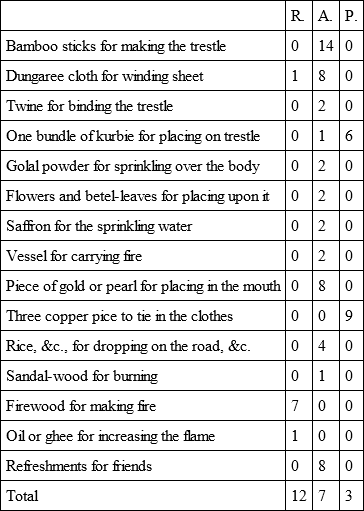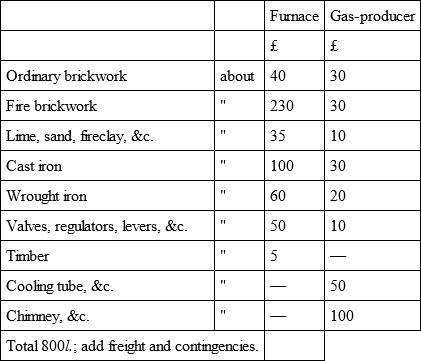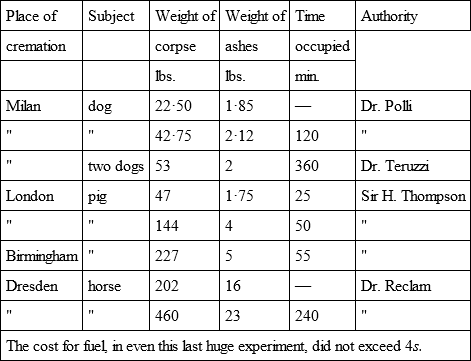 полная версия
полная версияCremation of the Dead
Baker, 'Laws relating to Burial,' 4th ed. London: 1874. Mr. Baker was kind enough to read over the proof of this chapter.
98
By Dr. Tripe.
99
During an official enquiry held by Mr. Holland, in November 1874, into the management of the Tooting cemetery, it transpired that four or five inches of intervening earth had been deemed necessary by the inspector of the cemetery, instead of the twelve inches stipulated by law. In the case of private graves the coffins had been laid without any intervening earth at all.
100
The Congress of Hygiene at Brussels recommended an intervening space of 400 mètres between a cemetery and any habitation.
101
The Greek word cemetery means a sleeping-place, and the idea of rest would be far better conveyed if only ashes were laid there, as no further atomical change would be possible.
102
In the Tooting cemetery enquiry, November 1874, it was proved that although the subsoil required draining, the merest surface drainage had been resorted to. The Burial Board admitted that in one instance a coffin had been deposited in a grave with water in it sufficient to cover it.
103
Patent Office Records.
104
'The decomposition of bodies gives rise to a very large amount of carbonic acid. Ammonia and an offensive putrid vapour are also given off. The air of most cemeteries is richer in carbonic acid (·7 to ·9 per thousand – Ramon de Luna), and the organic matter is perceptibly large when tested by potassium permanganate.' – Dr. Parkes, 'Practical Hygiene,' 4th edit. 1873.
105
See foot-note, p. 53.
106
Dr. De Pietra Santa.
107
'In vaults the air contains much carbonic acid, carbonate or sulphide of ammonium, nitrogen, hydrosulphuric acid, and organic matter. Fungi and germs of infusoria abound.' – Dr. Parkes, 'Practical Hygiene,' 4th ed.
108
Raulin.
109
By Dr. Adams, of Pittsfield.
110
Frazer.
111
The cemeteries at Finchley, according to Mr. Lowe, are drained into an open brook, and the drainage eventually runs into the River Brent. The cemetery at Tooting at the present moment discharges into an open ditch, and this flows into the River Wandle, from which many of the inhabitants in its vicinity are accustomed to draw supplies.
112
Dr. De Pietra Santa.
113
The Rev. S. Long.
114
Lieut. Holland.
115
Burton.
116
In 1849.
117
For further details under this head, see 'La Crémation des Morts,' par Dr. Pietra Santa.
118
Dr. Borgiotti, quoted by Dr. Golfarelli.
119
'Echo,' Sept. 23, 1874.
120
'Sulla Cremazione dei Cadaveri.'
121
'Sulla Incinerazione dei Cadaveri.'
122
'Sulla Cremazione dei Cadaveri.'
123
Ibid.
124
Ibid.
125
'Sulla Incinerazione dei Cadaveri.'
126
'La Cremazione dei Cadaveri.'
127
Ibid.
128
'Sulla Incinerazione dei Cadaveri.'
129
'La Cremazione e l'Igiene.'
130
'Humatio vel Crematio.'
131
'Intorno alla Cremazione dei Cadaveri.'
132
'La Cremazione dei Cadaveri.'
133
'L'Incinerazione dei Cadaveri è ammissibile?'
134
'La Cremazione dei Cadaveri.'
135
Ibid.
136
'Sulla Cremazione dei Cadaveri.'
137
'La Cremazione dei Cadaveri.'
138
'La Cremazione dei Cadaveri umani.'
139
'L'Incinerazione dei Cadaveri è ammissibile?'
140
'Inumazione, Imbalzamazione e Cremazione dei Cadaveri.'
141
In the 'Osservatore Cattolico.'
142
In the 'Annali di Chimica,' &c.
143
In the 'Gazette d'Andelfingen.' See also 'Leichenverbrennung als rationellste Bestattungsart.'
144
The same remark was made by Napoleon at St. Helena, when expressing his wish that his body might be burnt.
145
Le 'Pungolo' de Milan.
146
'Sépultures Nationales.'
147
It is worthy of notice, that upwards of thirty years ago Honoré de Balzac, in his novel Madame Jules, represents the husband of the dead lady as applying to the Minister of the Interior for leave to burn her body, and upon obtaining it, he put the ashes in an urn, and placed the latter in his cabinet. He was evidently in favour of the scheme, and chose to record his approval of it in this way.
148
'La Presse.'
149
'France Médicale.'
150
'Gazette Hebdomadaire.'
151
'L'Union Médicale.'
152
'La Crémation des Morts en Italie.'
153
'La Crémation des Morts en France et à l'étranger.'
154
By Dr. Janssens in the 'Journal de la Société Royale des Sciences Médicales et Naturelles de Bruxelles,' 1873.
155
'Brûlez les corps et ne les ensevelissez pas.'
156
'L'Indépendance Belge,' avril 1874.
157
'Brûlons nos morts,' 1874.
158
'Times,' May 1874.
159
On the fourth day of Pentecost.
160
'Cologne Gazette,' June 11, 1874.
161
'Jewish Chronicle,' April 10, 1874.
162
'Die Leichenverbrennung,' 1855, and 'Denkschrift von Leichenverbrennung,' 1860.
163
'Ueber Leichenverbrennung,' 1874.
164
'De la Crémation des Cadavres,' 1874.
165
'Sur le Procédé régénérateur et la manière de le pratiquer.'
166
In the 'Penn Monthly,' June 1874, and since reprinted separately.
167
'Chicago Daily Inter-Ocean,' March 1874.
168
Henry Laurens, first President of the American Congress, and later on, George Opdyks.
169
'Hydriotaphy, or Urn Burial,' 1658, and other editions.
170
'Origin of Cremation.' Proceedings of the Royal Society of Edinburgh, vol. viii.
171
'Burning the Dead, or Urn Sepulture,' by Mr. Chas. Cobbe. A few copies are still obtainable from Knowles, Celbridge Place, Bayswater, London.
172
Medical Officer of Health for Hampstead. Reports for the years 1857-1858, 1864, 1867, 1873, and 1874.
173
'Cremation.' H. S. King & Co., London. 2nd ed. 1s.
174
Since the publication of Sir Henry Thompson's work, and the reports of the active propaganda which is being carried on abroad, a great number of articles, favourable or well inclined to the practice, have appeared in the public press: for instance, in the 'Daily News,' 'Telegraph,' 'Standard,' 'Morning Advertiser,' 'Globe,' 'Saturday Review,' 'Court Journal,' and numerous illustrated and other papers. The 'British Medical Journal,' 'Lancet,' 'Medical Press and Circular,' 'Medical Record,' 'Sanitary Record,' 'Students' Journal and Hospital Gazette,' &c., have also borne witness to its value as a sanitary measure. Both Church and Nonconformist journals have moreover written in its favour, and several able articles have appeared in the periodicals, for example, in the 'Dublin University Magazine' and 'Westminster Review.' Most valuable assistance, demanding special notice, has also been rendered to cremation by that highly scientific periodical, 'Iron.' The process has also been made the subject of discussion in various debating societies, and in May 1874 the Cambridge University Union adopted a motion by 101 votes to 42 in favour of introducing it into England.
175
'We disapprove the present custom of burying the dead, and desire to substitute some mode which shall rapidly resolve the body into its component elements by a process which cannot offend the living, and shall render the remains absolutely innocuous. Until some better method is devised, we desire to adopt that usually known as Cremation.'
The conditions of membership are: —
I. – Adhesion by signature to the above declaration.
II. – The payment of an annual subscription of one guinea, or a single payment of ten guineas.
In order to carry out the above objects it has been resolved to raise funds for the purpose of carrying into operation the practice of cremation through the agency of cemetery companies, parochial and municipal authorities, or other public bodies.
176
In the play of 'Virginius' the body of Virginia is represented as having been placed in an urn, and when the distraught father enquires for his missing daughter, the vase is placed in his hands by the sorrowing lover. When this scene is presented, the thrill which seizes the audience is succeeded by a sensation of admiration at the eminently superior system of the ancients. I have seen the actor Brooke in this tragedy, and the effect which he here produced was inexpressible. Many whom I have consulted as to the feelings engendered at this point, have invariably declared that they were at the time complete converts to cremation, and that the sense of approval only left them when they began to realise how impossible were funeral pyres in this country. Happily the Siemens apparatus is now at hand, and its suitability proved beyond all cavil.
177
Laurentius, 'De funeribus antiquorum;' Kirchmannus, 'De funere Romanorum;' Montfaucon, 'Les funérailles des Grecs, des Romains,' &c.; Muret, 'Cérémonies funèbres de toutes les nations;' Porcacchi, 'Funerali antichi;' and many others to be found in public libraries.
178
See Trelawney's 'Last Days of Shelley and Byron.'
179
It has been seriously debated by some eminent men whether or not the ashes should be utilised, instead of being thrown away or gathered for preservation in urns.
180
The cost of a Hindoo funeral of the humbler class in the neighbourhood of Poona, according to Col. Martin, is as follows: —

181
The following compilation from a burial service of the Brahmins, who are the priests of all the other castes of Hindoos that burn their dead, may prove interesting to the reader. It is extracted from the 'Sacred Anthology.'
'O Earth! to thee we commend our brother: of thee he was formed, by thee he was sustained, and unto thee he now returns.
'O Fire! thou hadst a claim on our brother during life: he subsisted by thy influence in nature: to thee we commit his body, thou emblem of purity; may his spirit be purified on entering a new state of existence.
'O Air! while the breath of life continued, our brother respired by thee: his last breath is now departed, to thee we yield him.
'O Water! thou didst contribute to the life of our brother: thou wert one of his sustaining elements: his remains are now dispersed, receive thy share of him who has now taken an everlasting flight.'
182
'Iron.'
183
See foot-note, p. 39.
184
F. A. Feudge.
185
The descriptions of Dr. Santa are so admirably translated in 'Iron,' that I quote from that paper nearly in full.
186
From a translation in the 'Saturday Journal.'
187
Medical Inspector of Burials for England and Wales.
188
For a scientific description of the patent regenerative gas furnace which took the prize medal at the London Exhibition of 1862 and the grand prix at the Paris Exposition of 1867, see the 'Journal of the Chemical Society' for July 1873; the lecture delivered by the late Professor Faraday at the Royal Institution on June 20, 1862; and the description published by Dr. Siemens, London, 1874.
The minimum cost of a complete establishment for cremation upon the foregoing model, i.e., for the furnace and gas-producer as given in Plate II., but not including a mortuary building, would be as under: —

189
'Voyage autour du Monde.'
190
For full details of the carbonisation, see the 'Morning Advertiser,' Oct. 20 and Nov. 15, 1874, and the 'Morning Post,' Nov. 13, 1874, which contain translations from the German press.
191
About 6l.
192
Three other experiments were made upon human remains by Dr. Brunetti, with nearly similar results.
193
An emaciated corpse from the town hospital.
194
Wife of an English baronet.
195
Wife of a South German physician.
196
In case any reader would like to compare the above results with those derived from the cremation of the lower animals, I append the following recent instances variously treated.

197
When the body has to be conveyed for a very long distance to the place of cremation, it might be necessary to practise some simple method of embalming, and this any surgeon is capable of performing. In the case of the English lady who was recently taken to Dresden, Mr. Garstin of London was resorted to.
198
There is no doubt that public mortuaries will soon be established throughout the country, as in some parts of the Continent and in some large English towns now. Sanitary science calls aloud for their establishment generally, and the practice of permitting the dead to remain in the habitable rooms of the poor has proved very repugnant to decency and inimical to public health.
199
The princes of Tartary use this mountain silk, as it is called, even now.
200
Frazer.
201
Wanklyn.
202
See Plate I.
203
At the cremation of the body of an English lady at Dresden in October last, arrangements were made for observing the progress of combustion, and this was permitted under the peculiar circumstances. It is not however intended anywhere to practise even a partial exposure, nor would the English pattern of cinerator permit it. When the time needful for reduction has been accurately calculated, such exposure will be unnecessary. With the improved apparatus half an hour will probably be sufficient.
204
A cubic space of six inches would accommodate the ashes of the strongest man.
205
This drawing was kindly made for me by my friend Mr. E. F. C. Clarke, architect, of London, whose pencil has also furnished me with the sketch of the family columbarium in Plate V.
206
The tombs in Magna Græcia and Etruria were subterranean ones, the body being laid upon the ground, and around it were placed the painted vases. The tombs were made to bear as much resemblance as possible to the abodes of the living, and the walls were frequently painted with scenes from the upper world.
207
A. P. Reid.
208
Nicolo di Coti.
209
J. E. Price.
210
H. M. Westropp.
211
The artist, Mr. J. E. Newton, an exhibitor at the Royal Academy of 1874. I have engraved a few of his designs.
212
The above remarks do not refer to those monster urns in which the whole body was entombed unburnt. Some of these measure six feet in length and four and a half feet in width. One found at Dardanus was able to accommodate six persons. See the 'Illustrated London News' of April 26, 1856.
213
My friend Mr. Clarke has very kindly sketched, in elucidation of this view, the vessels shown in the family mausoleum sketched in Plate V.
214
Numbers of these relics were dug up at both places, in 1855 and 1856, by Mr. Spencer Wells, Dr. Kirk, Mr. Calvert, Mr. Brunton, myself, and others.
215
The church of St. Ursula; the bones are said to be those of the Eleven Thousand Virgins.
216
This is urged by Mr. Baker, the author of the 'Laws relating to Burial,' in a letter addressed to me.

